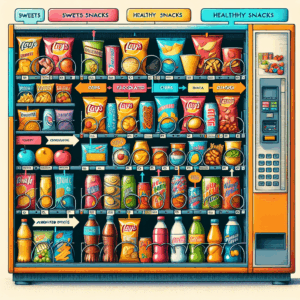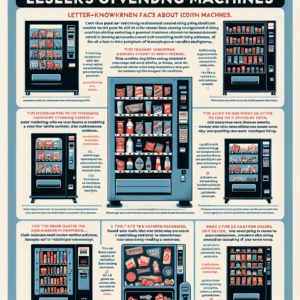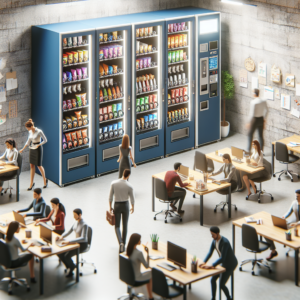Integration of Digital Payments
Understanding the Digital Payment Shift
In today’s fast-paced world, carrying cash is almost a thing of the past, especially in office settings. In my experience, offices that have embraced digital payment systems in vending machines have witnessed a smoother transaction process. There’s a certain efficiency that comes with simply tapping a card or phone, that can’t be matched by fumbling for exact change.
I’ve noticed that with cashless systems, there’s an increase in usage because people are more likely to indulge in snacks or a coffee when payment methods are easy. There’s a psychological edge to not physicalize the money you’re spending; it just feels easier to buy that extra snack when you don’t need to dig out physical money.
Moreover, with digital payments, tracking expenses becomes a breeze. I’ve seen colleagues who never used to track their snack spending suddenly getting regular updates on their spending habits. It might seem trivial, but it’s a great way for people to become more conscious of where their money is going.
Boosting Convenience in the Office Environment
The convenience factor is massive when you think cashless in the office. It’s not just about speed; it’s about accessibility. I remember times when I was caught short of cash, but now, that’s a worry of the past with the cashless vending options.
Picture this: you’ve just wrapped up a long meeting, and all you want is a quick snack or a drink. Having a cashless vending machine nearby means you can grab what you need without even hitting the ATM. Life-saver, right?
In my personal experience, offices that implement these cashless systems find a noticeable drop in lines during break times. People are in and out of the machines quicker, leaving more time to enjoy their break or even squeeze in some extra tasks.
Security Perks of Going Cashless
A perhaps underestimated benefit of cashless vending is security. Handling cash, especially in high-volume areas, has always been a security risk. But when you’re dealing with all digital transactions, that risk significantly diminishes.
I’ve heard from managers that they no longer worried about checking cash levels or managing shortages with digital. It’s a world where sticky fingers can’t reach into a machine, and transactions are transparent and traceable.
This added layer of security not only protects the business but also gives employees peace of mind. They know their transactions are safe and sound, further encouraging them to use the services provided.
Impact on Employee Productivity
Enhancing Break Times with Speed
Let’s be real, time is often a scarce resource in the office. The speed and efficiency brought by cashless vending change how employees spend their break times. I’ve seen first-hand how this quick access can reshape the day-to-day in an office.
There’s less stress over queuing and waiting, which means employees can actually focus on relaxing during their breaks. In my experience, when breaks genuinely feel like breaks, productivity skyrockets afterwards.
This isn’t just a theory; I’ve watched teams work at a higher pace and with more creativity after efficient use of vending services. It’s like a little reset button, recharging everyone for what’s next on the agenda.
Reducing Downtime due to Payment Issues
Payment hiccups can cause unnecessary downtime. Who hasn’t stood behind a colleague trying to work out a broken machine? With cashless systems, this issue significantly reduces, leading to more productive use of break periods.
I’ve spent too many minutes in my career listening to the sound of coins jamming or cards being declined. Now, with updated machines, it’s virtually unheard of. Less downtime over small tasks leads to more time spent focusing on what’s really important.
I’ve chatted with several managers who appreciate the role cashless vending plays in keeping people on task and reducing idle time. The fewer interruptions, the better people work, and this is one comprehensive way to reduce those interruptions.
Encouraging Teams to Collaborate During Breaks
What’s a break time without a bit of social interaction? I find cashless vending encourages more group activities during breaks. It’s quicker to get snacks, which means more time to huddle and chat with teammates.
I’ve personally witnessed groups using their extra few minutes to brainstorm, catch up, or even plan non-work-related outings while they enjoy their vending fare. It builds camaraderie and friends in the workplace.
This kind of informal team-building shouldn’t be underestimated; the strongest ideas sometimes come when people aren’t glued to their desks. Collaboration happens anywhere and cashless vending just gives a little nudge in the right direction.
Encouraging Healthier Choices
Accessibility to Better Options
One of the things I’ve noticed with modern vending machines going cashless, is the increased availability of healthier snacks and drinks. With digital screens, options can be updated more frequently to include nutritious choices.
I’ve talked to suppliers who are thrilled to offer a wider range of low-sugar and organic products because they’re seeing a demand largely made possible by cashless technology. Ordering these options is easier and more flexible.
From experience, offering better choices encourages better habits. When you make the healthier option the convenient option, people are more likely to choose it. It’s part of creating an overall healthier workplace culture.
Encouraging Mindful Eating
With transactions being digital, employees become more mindful of what they’re consuming. In my observations, workers think twice about their snacking habits when they’re faced with digital receipts and monthly reports.
I’ve found that people appreciate being able to track what they eat day-to-day. It leads to more thoughtful choices and helps curb unnecessary snacking because spending is not invisible as it often is with cash purchases.
This has a knock-on effect on overall health. It’s not just being about mindful—in the long run, such practices can help reduce health-related absences, which is a win for everyone involved.
Promoting Sustainability
Many cashless vending setups now highlight sustainability initiatives, with less packaging used and incentives for using reusable containers or cups. I’ve been thrilled to see this eco-friendly angle become a key selling point.
In several setups I’ve worked with, machines even offer discounts when you use a personal container. This encourages employees to think about their environmental impact alongside their diet choices.
I’ve always believed small changes lead to big impacts, and from what I’ve seen, a single office shifting inventory could lead to substantial waste reduction over time. It’s all about encouraging change on a sustainable scale.
Facilitating Remote Work Trends
Aiding Hybrid Work Models
As offices move towards hybrid models, cashless vending still plays a role, supporting those who split their time between home and office. It’s all about flexibility, and having these systems in place offers just that.
When I’m in the office, I appreciate being able to grab a quick snack or coffee without hassle, maintaining my usual work pace as if I were at home. This kind of continuity is crucial for adapting to new work environments.
I’ve found this setup gives me the best of both worlds. I’m productive at home, but when in the office, I can seamlessly continue my working habits without interruption thanks to streamlined services like cashless vending.
Supporting Offices as Social Spaces
I’ve noticed that cashless vending can transform offices into more social spaces, even in an era where remote work prevails. These machines encourage people to come into the office, even for a few hours.
The rapid access to on-the-go meals and snacks leads people—remote or otherwise—to use office visits as a chance to engage. I’ve seen coworkers spontaneously gather by the vending area, strengthening team bonds.
Creating an office that’s a hub of not only work but social interaction can help retain talent and boost morale. It’s a fine balance, and cashless systems have been surprisingly pivotal in encouraging this balance.
Integrating Seamlessly with Remote Apps
Many modern vending operations link up with mobile apps allowing employees to pre-order or even have items delivered to nearby hubs or their desks. From personal experience, this connectivity bridges us to the office where we are true digital nomads.
Remote work doesn’t limit access to office amenities anymore, and that’s a huge shift towards a more integrated work culture. It’s kind of cool knowing I can order from the office vending machine from the comfort of my couch.
By pairing technology with flexibility, offices can belong to the workspace of the future, promoting not just productivity but genuine well-being too. Cashless vending is serving as a quiet force in this transition.
Frequently Asked Questions
What are the benefits of cashless vending in workplaces?
Cashless vending offers increased convenience, speeds up transactions, boosts security, encourages healthier choices, and supports modern workplace trends such as flexible and remote work.
How does cashless vending encourage healthier choices?
Cashless options increase accessibility to healthier products and allow employees to track their spending and dietary habits through digital receipts, promoting mindful eating and wellness.
Is cashless vending really secure?
Yes, cashless systems reduce the security risks associated with handling cash and provide transparency and security in transactions, reducing the potential for theft or fraud.
Can cashless vending support remote or hybrid work models?
Absolutely! Cashless vending aids hybrid models by maintaining efficiency and flexibility in the office. Many systems also integrate with apps to offer additional convenience to remote workers.



